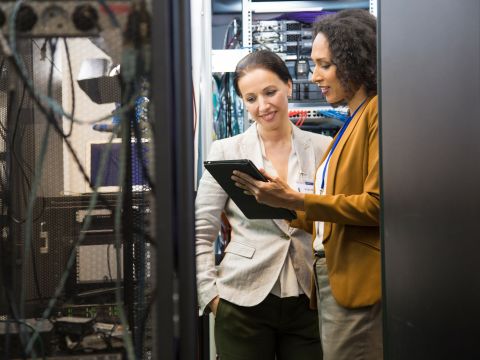Keeping the Lights On: Exploring Data Centre Power Systems
There are around 8,000 data centres in the world, as of 2023. They come in all shapes, sizes, and performance levels (classified in data centre tiers). But regardless of where they’re located or how big they are, all data centres need three main ingredients:
- Fast connectivity
- Robust cooling
- Reliable power
Okay, so there’s a few more ingredients you’d need to add to the pot to make a data centre work (like security, accessibility, sufficient space and so on) – but without these three things, you’re just storing IT hardware!
We recently covered data centre cooling, which is itself a deep and rich topic, and we’re sure to cover connectivity in more detail soon, too – yet of all of these ingredients, power is probably the most crucial. Cooling can be built in and expanded upon, and connectivity comes in many forms. But without power, nothing can run.
Data centre power isn’t as simple as plugging IEC cables into a wall socket. There have to be multiple paths for power, separated by priority. Cooling systems need independent power supplies. All power systems must have redundancies built in – because even a short period of downtime can cost the data centre (and their customers) huge sums of money.
Let’s take a closer look, and try to scratch the surface of data centre power systems…
How are data centres powered?
In the USA alone, data centres use more than 90 billion kilowatt-hours of electricity a year.
That’s the equivalent of roughly 34 coal-fired power plants. That’s an awful lot of energy. So, where does it come from?
For most data centres, their main source of power is the electric grid – the same one that keeps the lights on at home. However, due to the MASSIVE power consumption, the power needs to be conditioned, amplified, and routed carefully to keep the flow consistent.
The power type used in data centres is called “three-phase” power, which is different to domestic, single-phase power. It’s used in industrial operations, like factories, that have large workloads and low tolerance for downtime.
A three-phase circuit provides greater power density than residential power at the same amperage – which makes it easier to balance power loads and increases efficiency. The voltage output is far higher, and the power is more steady and consistent.
Some data centres have their own on-prem power generation – like wind turbines and solar panels. This might be the way all data centres are powered in the future, but today, this is usually supplementary and not a primary power source.
Higher-tiered data centres will have more than one main route for power, like GS2, which has a double-redundant primary power supply.
So, that’s the input covered. What happens next?
Well, typically, the power is then routed into power conditioners, fuses, circuit breakers, UPS (uninterrupted power supply) systems, surge protection, and distribution boards. The power can be centrally monitored and distributed from the data centre’s control rooms, to make sure all servers and cooling systems have enough power.
In the event of the main power source going down, the UPS will feed the system immediately with electricity – but only very briefly (for up to five minutes), while backups come online.
And this is where it gets interesting…
Data centre backup power
Backup power is a vital element of powerign a data centre – because no matter how good the main power source is, outages happen. In the data centre business, downtime is not an option, and efforts to reduce it are ongoing.
The problem is, grid power is not 100% reliable, and on-premises power generation alternatives can currently only provide so much energy. And so, data centres tend to install diesel generators as their preferred backup power source.
Why?
Because even though diesel is a dirty fuel, it’s relatively cheap and quite efficient. It’s easy to store, and doesn’t burn as readily as petrol – making it a lower fire risk.
Diesel engines are powerful and have a lot of torque, making them excellent for powering generators. The exhaust fumes can also be captured by turbines, for additional power generation, maximising efficiency.
But they have another trick – diesel engines are nigh on indestructible and can even work in flood conditions, if they have a snorkel for air intake. In a disaster situation, every data centre wants a diesel engine for backup power.
Tier 3 data centres (like GS2, which is at least a tier 3 and possibly higher) store enough fuel on-site to run their generators at full capacity for 48 hours – and they have contracts with fuel delivery companies to supply diesel 24 hours a day, 365 days a year. There’s even spare generators on hand, just in case one of them breaks down.
Nothing is as efficient as grid power, but having this kind of near-unlimited backup power is enough to sell the data centre’s resilience to uptime-obsessed businesses.
Speaking of which…
Keep Powering Through – with Our US and UK Data Centres
Is your business focused on data centre uptime? We operate rackspace at some of the world’s most reliable data centres (minimum tier 3) – to give our customers unbeatable performance.
Want to know more? Just call us on 01509 80 85 86 or send your message to [email protected].
More services to help
We offer a comprehensive range of IT services to suit all businesses - from "helpdesk"-style IT support to data centre hosting services.


IT Support
Your business doesn’t run itself; and neither do its IT systems. From email to Internet, your back-up server to your phone system, you need technology to run smoothly so your business can do the same.


Private Cloud
Our scalable private cloud services run on dedicated hardware. You’ll get 24/7 support, total security and lightning-fast speed; all at a fixed, all-inclusive monthly cost.


Data Centre
Our fully managed colocation services make use of data centres across the UK, to securely house your network equipment.